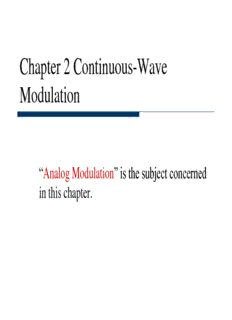
Notes for Analog Communications for II- II ECE students PDF
Preview Notes for Analog Communications for II- II ECE students
Chapter 2 Continuous-Wave Modulation “Analog Modulation” is the subject concerned in this chapter. 2.1 Introduction Analog communication system The most common carrier is the sinusoidal wave. (Analog) Carrier wave 2.1 Introduction Modulation A process by which some characteristic of a carrier is varied in accordance with a modulating wave (baseband signal). Sinusoidal Continuous-Wave (CW) modulation Amplitude modulation Angle modulation Sinusoidal carrier 2.1 Introduction Baseband signal Amplitude Modulation Frequency Modulation 2.2 Double-Sideband with Carrier or simply Amplitude Modulation Carrier c(t) A cos(2f ) c c Baseband m(t) Modulated Signal s(t) A [1 k m(t)]cos(2f t), c a c where k is amplitude sensitivity or modulation index a Two required conditions on amplitude sensitivity 1 + k m(t) 0, which is ensured by |k m(t)| ≦ 1. a a The case of |k m(t)| > 1 is called overmodulation. a The value of |k m(t)| is sometimes represented by “percentage” a (because it is limited by 1), and is named (|k m(t)|100)% a modulation. f >> W, where W is the message bandwidth. c Violation of this condition will cause nonvisualized envelope. 2.2 Overmodulation overmodulaion | k m(t) | 1 a 2.2 Example of Non-Visualized Envelope 2.2 Example of Visualized Envelope 2.2 Transmission Bandwidth s(t) A [1 k m(t)]cos(2f t) c a c A k A S( f ) c ( f f ) ( f f ) a c M ( f f ) M ( f f ) c c c c 2 2 Transmission bandwidth B = 2W. T 2W 2.2 Transmission Bandwidth Transmission bandwidth of an AM wave For positive frequencies, the highest frequency component of the AM wave equals f + W, and the c lowest frequency component equals f – W. c The difference between these two frequencies defines the transmission bandwidth B for an AM T wave.
Description: